Risk Management Analysis: A Report for BizOps Enterprises (BSBRSK501)
VerifiedAdded on 2023/01/13
|8
|1583
|27
Project
AI Summary
This project is a comprehensive risk management report focusing on BizOps Enterprises, a small-scale retail organization in Australia. The report begins with an introduction that highlights the company's operational context and the need for risk management due to internal and external challenges. The project includes a detailed discussion of key risks, including political, economic, social, legal, technological, and policy-related factors, along with potential sources of these risks and relevant legislation. It also reviews the current organizational policies and their links to identified risks. The report then outlines objectives, critical success factors, and a risk management plan template. A significant portion of the project is dedicated to the risk management process, covering implementation, monitoring, and evaluation strategies, particularly in the context of recruitment practices. The implementation strategy involves a step-by-step recruitment plan, the monitoring strategy focuses on the HR manager's oversight, and the evaluation strategy assesses the efficacy of the recruitment plan over a 12-month period, including the turnover rate of newly hired employees. The report concludes by emphasizing the relevance of the risk management strategies in helping BizOps Enterprises overcome its challenges and improve its business operations.
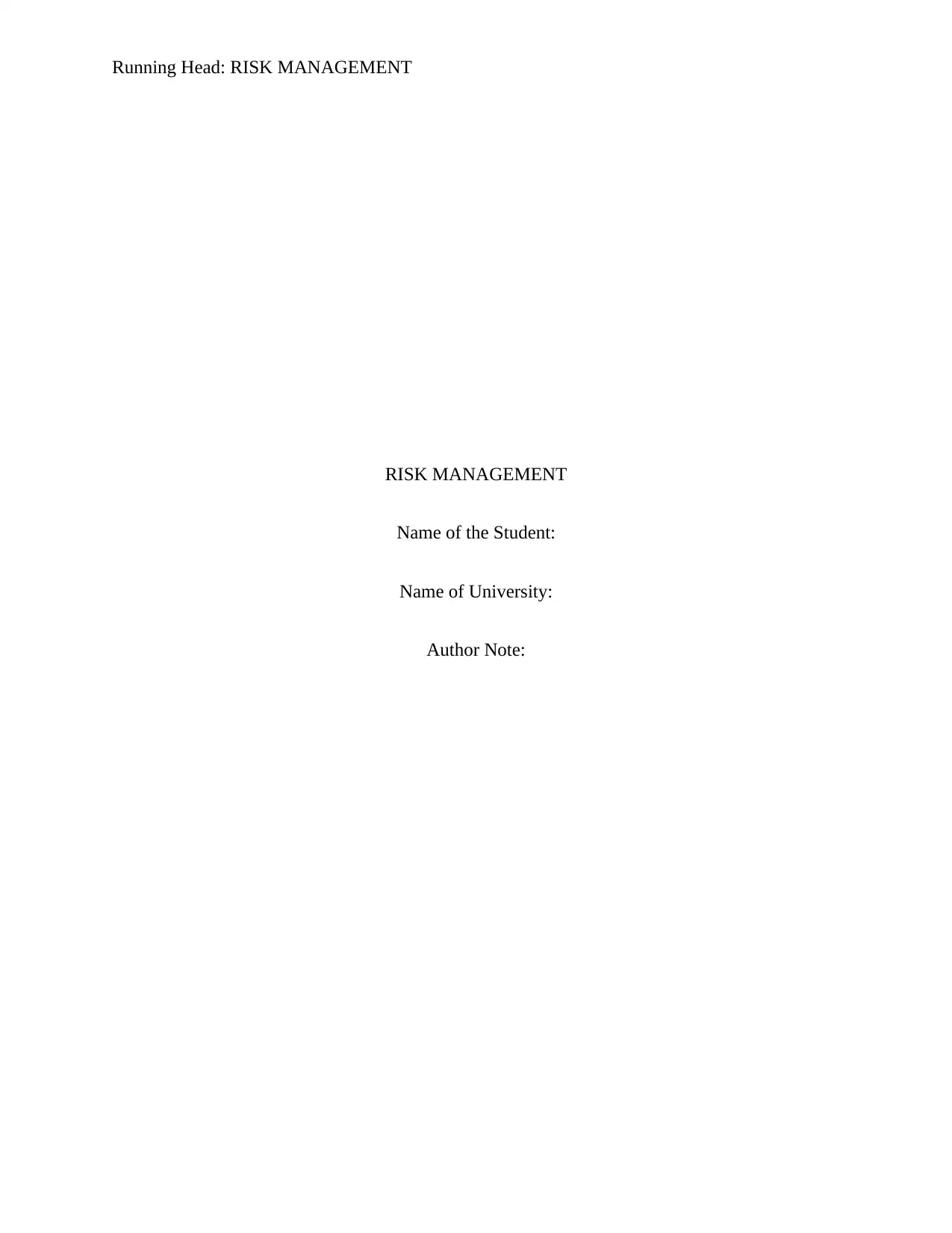
Running Head: RISK MANAGEMENT
RISK MANAGEMENT
Name of the Student:
Name of University:
Author Note:
RISK MANAGEMENT
Name of the Student:
Name of University:
Author Note:
Paraphrase This Document
Need a fresh take? Get an instant paraphrase of this document with our AI Paraphraser
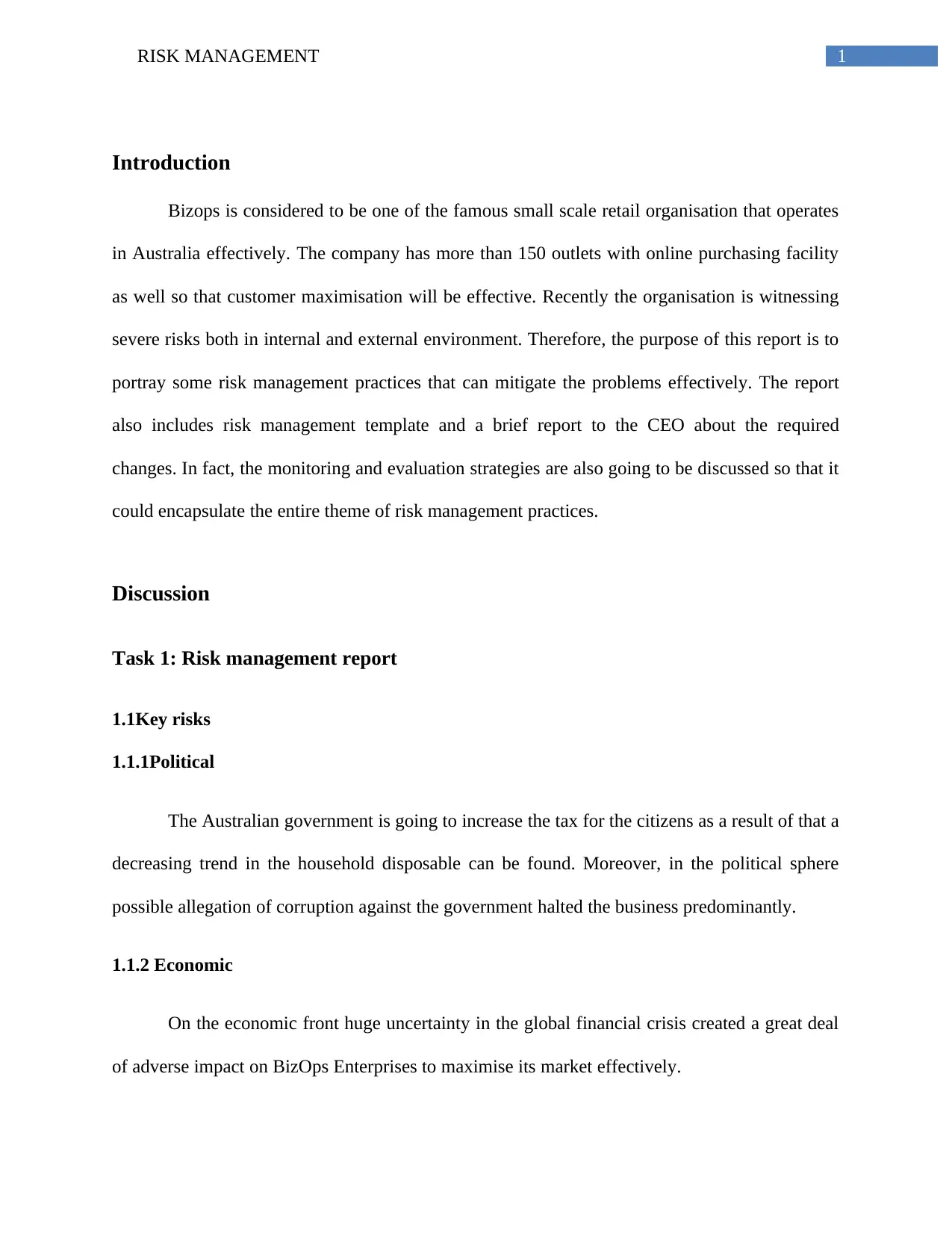
1RISK MANAGEMENT
Introduction
Bizops is considered to be one of the famous small scale retail organisation that operates
in Australia effectively. The company has more than 150 outlets with online purchasing facility
as well so that customer maximisation will be effective. Recently the organisation is witnessing
severe risks both in internal and external environment. Therefore, the purpose of this report is to
portray some risk management practices that can mitigate the problems effectively. The report
also includes risk management template and a brief report to the CEO about the required
changes. In fact, the monitoring and evaluation strategies are also going to be discussed so that it
could encapsulate the entire theme of risk management practices.
Discussion
Task 1: Risk management report
1.1Key risks
1.1.1Political
The Australian government is going to increase the tax for the citizens as a result of that a
decreasing trend in the household disposable can be found. Moreover, in the political sphere
possible allegation of corruption against the government halted the business predominantly.
1.1.2 Economic
On the economic front huge uncertainty in the global financial crisis created a great deal
of adverse impact on BizOps Enterprises to maximise its market effectively.
Introduction
Bizops is considered to be one of the famous small scale retail organisation that operates
in Australia effectively. The company has more than 150 outlets with online purchasing facility
as well so that customer maximisation will be effective. Recently the organisation is witnessing
severe risks both in internal and external environment. Therefore, the purpose of this report is to
portray some risk management practices that can mitigate the problems effectively. The report
also includes risk management template and a brief report to the CEO about the required
changes. In fact, the monitoring and evaluation strategies are also going to be discussed so that it
could encapsulate the entire theme of risk management practices.
Discussion
Task 1: Risk management report
1.1Key risks
1.1.1Political
The Australian government is going to increase the tax for the citizens as a result of that a
decreasing trend in the household disposable can be found. Moreover, in the political sphere
possible allegation of corruption against the government halted the business predominantly.
1.1.2 Economic
On the economic front huge uncertainty in the global financial crisis created a great deal
of adverse impact on BizOps Enterprises to maximise its market effectively.
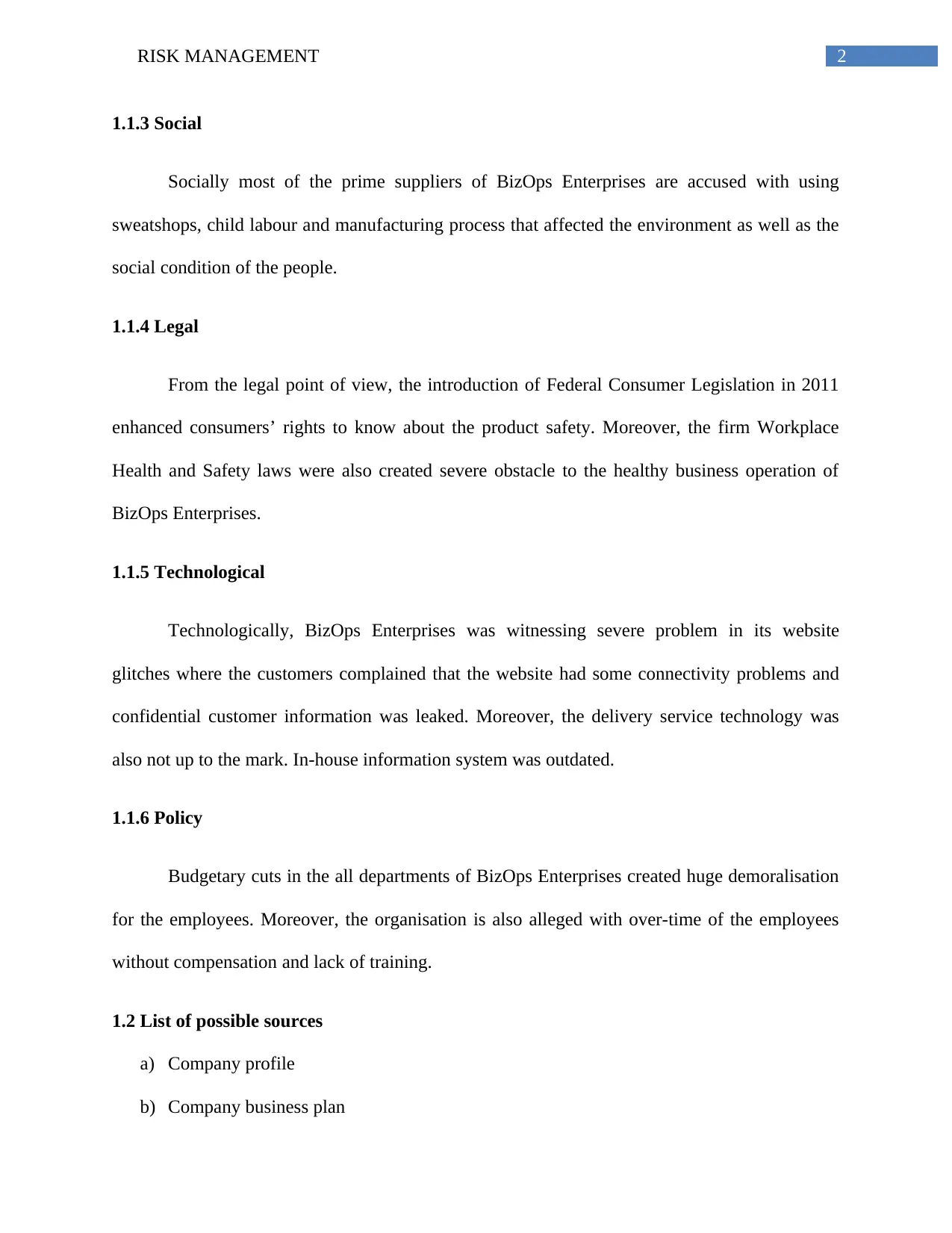
2RISK MANAGEMENT
1.1.3 Social
Socially most of the prime suppliers of BizOps Enterprises are accused with using
sweatshops, child labour and manufacturing process that affected the environment as well as the
social condition of the people.
1.1.4 Legal
From the legal point of view, the introduction of Federal Consumer Legislation in 2011
enhanced consumers’ rights to know about the product safety. Moreover, the firm Workplace
Health and Safety laws were also created severe obstacle to the healthy business operation of
BizOps Enterprises.
1.1.5 Technological
Technologically, BizOps Enterprises was witnessing severe problem in its website
glitches where the customers complained that the website had some connectivity problems and
confidential customer information was leaked. Moreover, the delivery service technology was
also not up to the mark. In-house information system was outdated.
1.1.6 Policy
Budgetary cuts in the all departments of BizOps Enterprises created huge demoralisation
for the employees. Moreover, the organisation is also alleged with over-time of the employees
without compensation and lack of training.
1.2 List of possible sources
a) Company profile
b) Company business plan
1.1.3 Social
Socially most of the prime suppliers of BizOps Enterprises are accused with using
sweatshops, child labour and manufacturing process that affected the environment as well as the
social condition of the people.
1.1.4 Legal
From the legal point of view, the introduction of Federal Consumer Legislation in 2011
enhanced consumers’ rights to know about the product safety. Moreover, the firm Workplace
Health and Safety laws were also created severe obstacle to the healthy business operation of
BizOps Enterprises.
1.1.5 Technological
Technologically, BizOps Enterprises was witnessing severe problem in its website
glitches where the customers complained that the website had some connectivity problems and
confidential customer information was leaked. Moreover, the delivery service technology was
also not up to the mark. In-house information system was outdated.
1.1.6 Policy
Budgetary cuts in the all departments of BizOps Enterprises created huge demoralisation
for the employees. Moreover, the organisation is also alleged with over-time of the employees
without compensation and lack of training.
1.2 List of possible sources
a) Company profile
b) Company business plan
⊘ This is a preview!⊘
Do you want full access?
Subscribe today to unlock all pages.

Trusted by 1+ million students worldwide
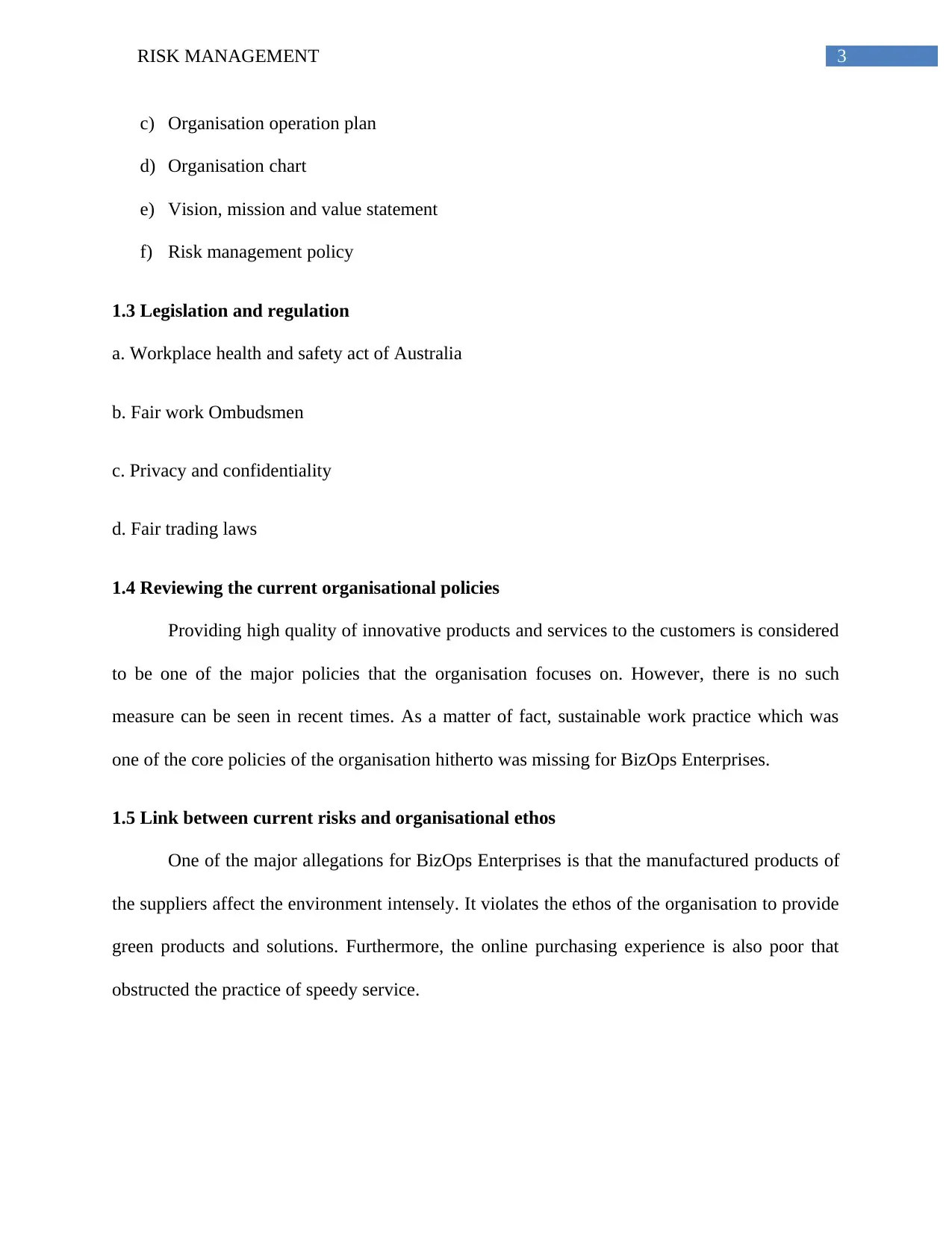
3RISK MANAGEMENT
c) Organisation operation plan
d) Organisation chart
e) Vision, mission and value statement
f) Risk management policy
1.3 Legislation and regulation
a. Workplace health and safety act of Australia
b. Fair work Ombudsmen
c. Privacy and confidentiality
d. Fair trading laws
1.4 Reviewing the current organisational policies
Providing high quality of innovative products and services to the customers is considered
to be one of the major policies that the organisation focuses on. However, there is no such
measure can be seen in recent times. As a matter of fact, sustainable work practice which was
one of the core policies of the organisation hitherto was missing for BizOps Enterprises.
1.5 Link between current risks and organisational ethos
One of the major allegations for BizOps Enterprises is that the manufactured products of
the suppliers affect the environment intensely. It violates the ethos of the organisation to provide
green products and solutions. Furthermore, the online purchasing experience is also poor that
obstructed the practice of speedy service.
c) Organisation operation plan
d) Organisation chart
e) Vision, mission and value statement
f) Risk management policy
1.3 Legislation and regulation
a. Workplace health and safety act of Australia
b. Fair work Ombudsmen
c. Privacy and confidentiality
d. Fair trading laws
1.4 Reviewing the current organisational policies
Providing high quality of innovative products and services to the customers is considered
to be one of the major policies that the organisation focuses on. However, there is no such
measure can be seen in recent times. As a matter of fact, sustainable work practice which was
one of the core policies of the organisation hitherto was missing for BizOps Enterprises.
1.5 Link between current risks and organisational ethos
One of the major allegations for BizOps Enterprises is that the manufactured products of
the suppliers affect the environment intensely. It violates the ethos of the organisation to provide
green products and solutions. Furthermore, the online purchasing experience is also poor that
obstructed the practice of speedy service.
Paraphrase This Document
Need a fresh take? Get an instant paraphrase of this document with our AI Paraphraser
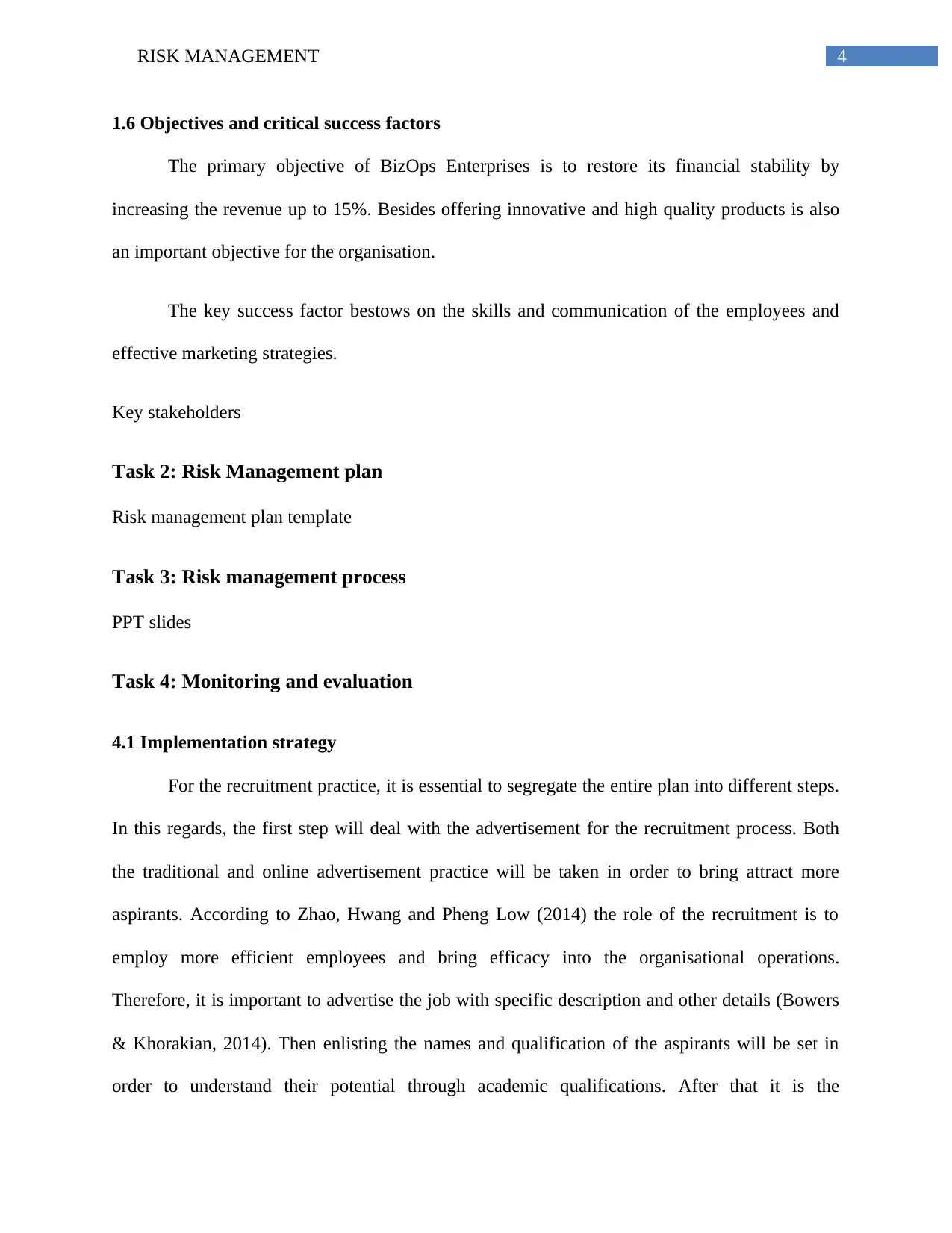
4RISK MANAGEMENT
1.6 Objectives and critical success factors
The primary objective of BizOps Enterprises is to restore its financial stability by
increasing the revenue up to 15%. Besides offering innovative and high quality products is also
an important objective for the organisation.
The key success factor bestows on the skills and communication of the employees and
effective marketing strategies.
Key stakeholders
Task 2: Risk Management plan
Risk management plan template
Task 3: Risk management process
PPT slides
Task 4: Monitoring and evaluation
4.1 Implementation strategy
For the recruitment practice, it is essential to segregate the entire plan into different steps.
In this regards, the first step will deal with the advertisement for the recruitment process. Both
the traditional and online advertisement practice will be taken in order to bring attract more
aspirants. According to Zhao, Hwang and Pheng Low (2014) the role of the recruitment is to
employ more efficient employees and bring efficacy into the organisational operations.
Therefore, it is important to advertise the job with specific description and other details (Bowers
& Khorakian, 2014). Then enlisting the names and qualification of the aspirants will be set in
order to understand their potential through academic qualifications. After that it is the
1.6 Objectives and critical success factors
The primary objective of BizOps Enterprises is to restore its financial stability by
increasing the revenue up to 15%. Besides offering innovative and high quality products is also
an important objective for the organisation.
The key success factor bestows on the skills and communication of the employees and
effective marketing strategies.
Key stakeholders
Task 2: Risk Management plan
Risk management plan template
Task 3: Risk management process
PPT slides
Task 4: Monitoring and evaluation
4.1 Implementation strategy
For the recruitment practice, it is essential to segregate the entire plan into different steps.
In this regards, the first step will deal with the advertisement for the recruitment process. Both
the traditional and online advertisement practice will be taken in order to bring attract more
aspirants. According to Zhao, Hwang and Pheng Low (2014) the role of the recruitment is to
employ more efficient employees and bring efficacy into the organisational operations.
Therefore, it is important to advertise the job with specific description and other details (Bowers
& Khorakian, 2014). Then enlisting the names and qualification of the aspirants will be set in
order to understand their potential through academic qualifications. After that it is the
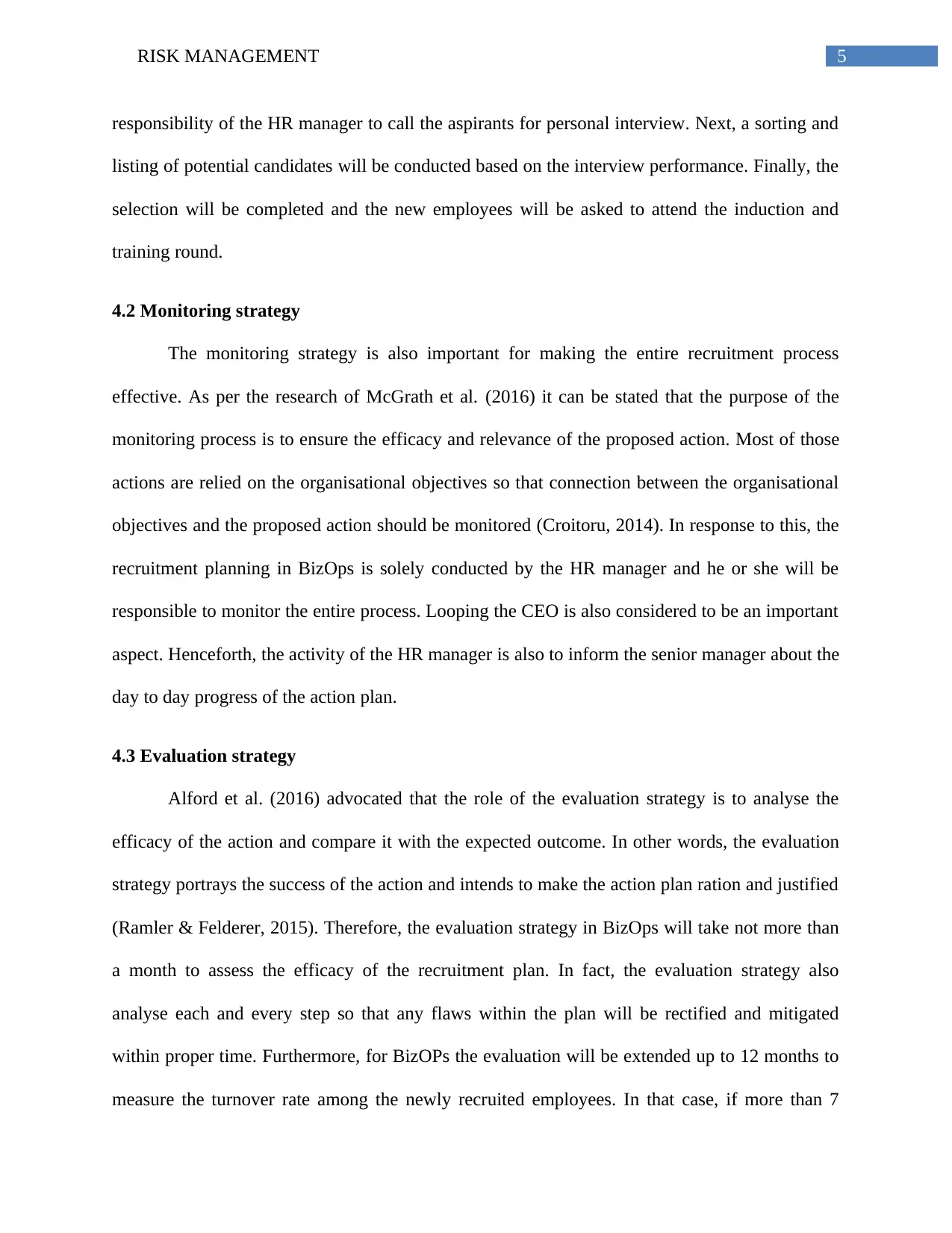
5RISK MANAGEMENT
responsibility of the HR manager to call the aspirants for personal interview. Next, a sorting and
listing of potential candidates will be conducted based on the interview performance. Finally, the
selection will be completed and the new employees will be asked to attend the induction and
training round.
4.2 Monitoring strategy
The monitoring strategy is also important for making the entire recruitment process
effective. As per the research of McGrath et al. (2016) it can be stated that the purpose of the
monitoring process is to ensure the efficacy and relevance of the proposed action. Most of those
actions are relied on the organisational objectives so that connection between the organisational
objectives and the proposed action should be monitored (Croitoru, 2014). In response to this, the
recruitment planning in BizOps is solely conducted by the HR manager and he or she will be
responsible to monitor the entire process. Looping the CEO is also considered to be an important
aspect. Henceforth, the activity of the HR manager is also to inform the senior manager about the
day to day progress of the action plan.
4.3 Evaluation strategy
Alford et al. (2016) advocated that the role of the evaluation strategy is to analyse the
efficacy of the action and compare it with the expected outcome. In other words, the evaluation
strategy portrays the success of the action and intends to make the action plan ration and justified
(Ramler & Felderer, 2015). Therefore, the evaluation strategy in BizOps will take not more than
a month to assess the efficacy of the recruitment plan. In fact, the evaluation strategy also
analyse each and every step so that any flaws within the plan will be rectified and mitigated
within proper time. Furthermore, for BizOPs the evaluation will be extended up to 12 months to
measure the turnover rate among the newly recruited employees. In that case, if more than 7
responsibility of the HR manager to call the aspirants for personal interview. Next, a sorting and
listing of potential candidates will be conducted based on the interview performance. Finally, the
selection will be completed and the new employees will be asked to attend the induction and
training round.
4.2 Monitoring strategy
The monitoring strategy is also important for making the entire recruitment process
effective. As per the research of McGrath et al. (2016) it can be stated that the purpose of the
monitoring process is to ensure the efficacy and relevance of the proposed action. Most of those
actions are relied on the organisational objectives so that connection between the organisational
objectives and the proposed action should be monitored (Croitoru, 2014). In response to this, the
recruitment planning in BizOps is solely conducted by the HR manager and he or she will be
responsible to monitor the entire process. Looping the CEO is also considered to be an important
aspect. Henceforth, the activity of the HR manager is also to inform the senior manager about the
day to day progress of the action plan.
4.3 Evaluation strategy
Alford et al. (2016) advocated that the role of the evaluation strategy is to analyse the
efficacy of the action and compare it with the expected outcome. In other words, the evaluation
strategy portrays the success of the action and intends to make the action plan ration and justified
(Ramler & Felderer, 2015). Therefore, the evaluation strategy in BizOps will take not more than
a month to assess the efficacy of the recruitment plan. In fact, the evaluation strategy also
analyse each and every step so that any flaws within the plan will be rectified and mitigated
within proper time. Furthermore, for BizOPs the evaluation will be extended up to 12 months to
measure the turnover rate among the newly recruited employees. In that case, if more than 7
⊘ This is a preview!⊘
Do you want full access?
Subscribe today to unlock all pages.

Trusted by 1+ million students worldwide
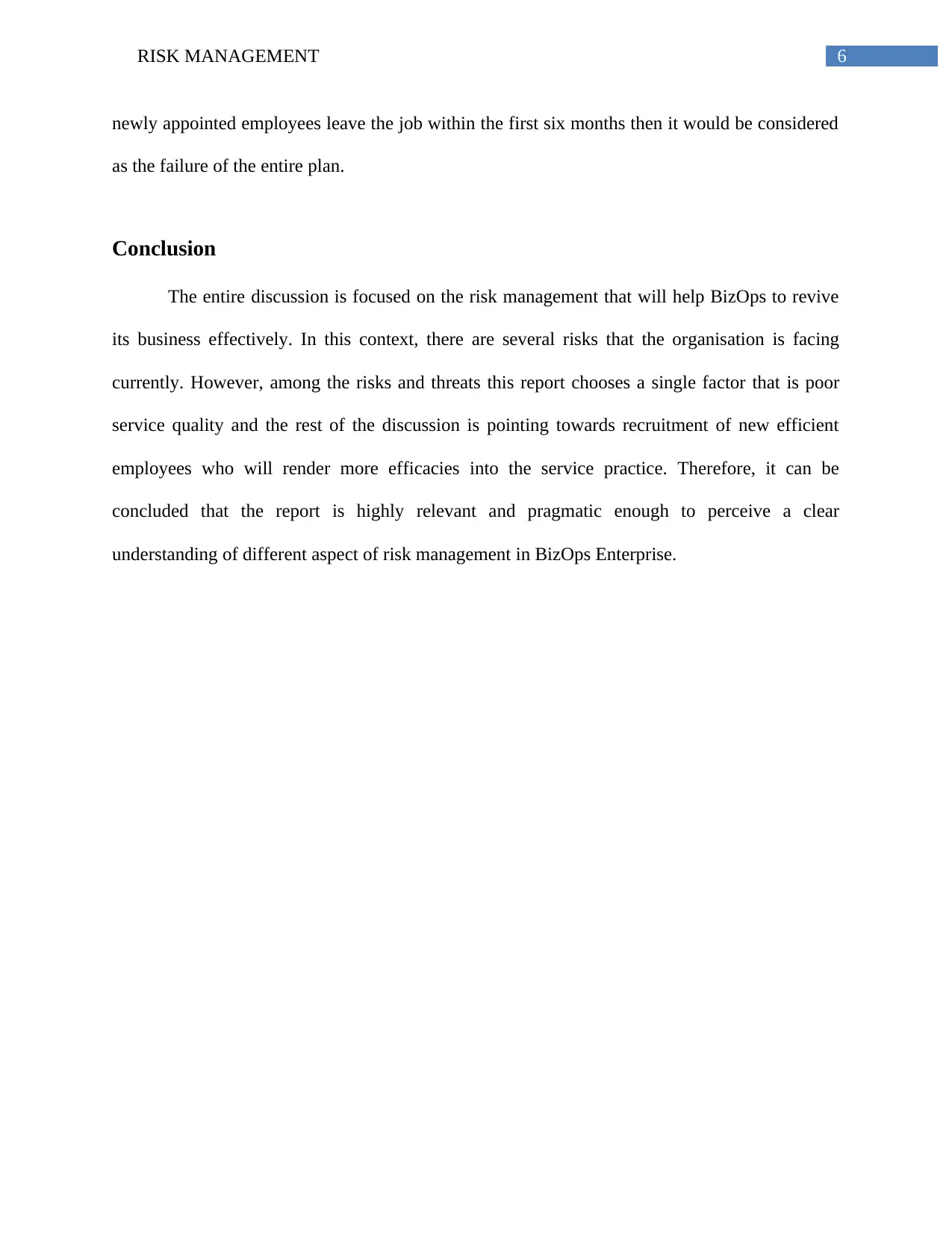
6RISK MANAGEMENT
newly appointed employees leave the job within the first six months then it would be considered
as the failure of the entire plan.
Conclusion
The entire discussion is focused on the risk management that will help BizOps to revive
its business effectively. In this context, there are several risks that the organisation is facing
currently. However, among the risks and threats this report chooses a single factor that is poor
service quality and the rest of the discussion is pointing towards recruitment of new efficient
employees who will render more efficacies into the service practice. Therefore, it can be
concluded that the report is highly relevant and pragmatic enough to perceive a clear
understanding of different aspect of risk management in BizOps Enterprise.
newly appointed employees leave the job within the first six months then it would be considered
as the failure of the entire plan.
Conclusion
The entire discussion is focused on the risk management that will help BizOps to revive
its business effectively. In this context, there are several risks that the organisation is facing
currently. However, among the risks and threats this report chooses a single factor that is poor
service quality and the rest of the discussion is pointing towards recruitment of new efficient
employees who will render more efficacies into the service practice. Therefore, it can be
concluded that the report is highly relevant and pragmatic enough to perceive a clear
understanding of different aspect of risk management in BizOps Enterprise.
Paraphrase This Document
Need a fresh take? Get an instant paraphrase of this document with our AI Paraphraser
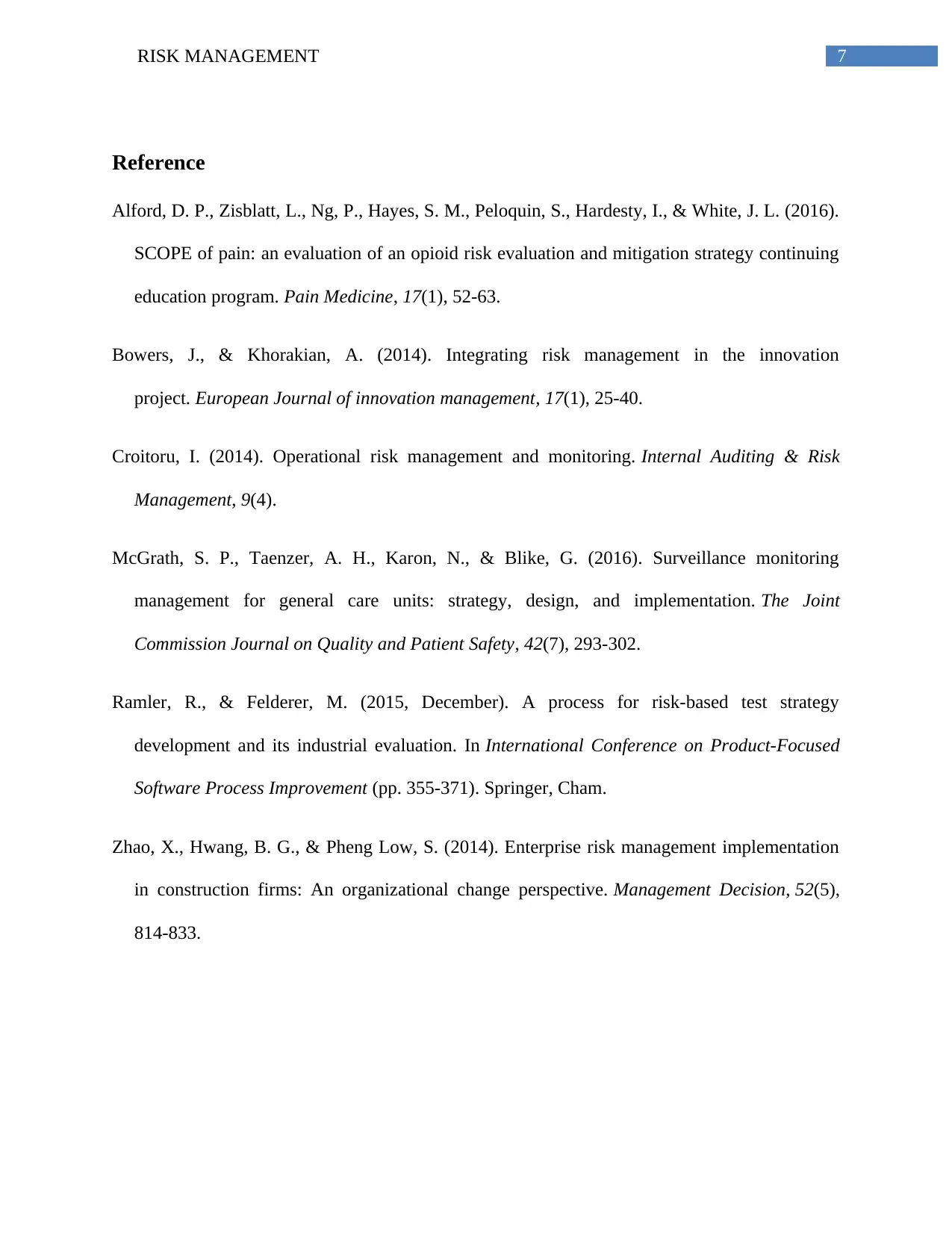
7RISK MANAGEMENT
Reference
Alford, D. P., Zisblatt, L., Ng, P., Hayes, S. M., Peloquin, S., Hardesty, I., & White, J. L. (2016).
SCOPE of pain: an evaluation of an opioid risk evaluation and mitigation strategy continuing
education program. Pain Medicine, 17(1), 52-63.
Bowers, J., & Khorakian, A. (2014). Integrating risk management in the innovation
project. European Journal of innovation management, 17(1), 25-40.
Croitoru, I. (2014). Operational risk management and monitoring. Internal Auditing & Risk
Management, 9(4).
McGrath, S. P., Taenzer, A. H., Karon, N., & Blike, G. (2016). Surveillance monitoring
management for general care units: strategy, design, and implementation. The Joint
Commission Journal on Quality and Patient Safety, 42(7), 293-302.
Ramler, R., & Felderer, M. (2015, December). A process for risk-based test strategy
development and its industrial evaluation. In International Conference on Product-Focused
Software Process Improvement (pp. 355-371). Springer, Cham.
Zhao, X., Hwang, B. G., & Pheng Low, S. (2014). Enterprise risk management implementation
in construction firms: An organizational change perspective. Management Decision, 52(5),
814-833.
Reference
Alford, D. P., Zisblatt, L., Ng, P., Hayes, S. M., Peloquin, S., Hardesty, I., & White, J. L. (2016).
SCOPE of pain: an evaluation of an opioid risk evaluation and mitigation strategy continuing
education program. Pain Medicine, 17(1), 52-63.
Bowers, J., & Khorakian, A. (2014). Integrating risk management in the innovation
project. European Journal of innovation management, 17(1), 25-40.
Croitoru, I. (2014). Operational risk management and monitoring. Internal Auditing & Risk
Management, 9(4).
McGrath, S. P., Taenzer, A. H., Karon, N., & Blike, G. (2016). Surveillance monitoring
management for general care units: strategy, design, and implementation. The Joint
Commission Journal on Quality and Patient Safety, 42(7), 293-302.
Ramler, R., & Felderer, M. (2015, December). A process for risk-based test strategy
development and its industrial evaluation. In International Conference on Product-Focused
Software Process Improvement (pp. 355-371). Springer, Cham.
Zhao, X., Hwang, B. G., & Pheng Low, S. (2014). Enterprise risk management implementation
in construction firms: An organizational change perspective. Management Decision, 52(5),
814-833.
1 out of 8
Related Documents
Your All-in-One AI-Powered Toolkit for Academic Success.
+13062052269
info@desklib.com
Available 24*7 on WhatsApp / Email
![[object Object]](/_next/static/media/star-bottom.7253800d.svg)
Unlock your academic potential
Copyright © 2020–2025 A2Z Services. All Rights Reserved. Developed and managed by ZUCOL.





